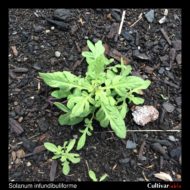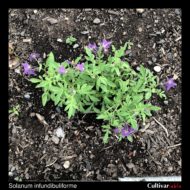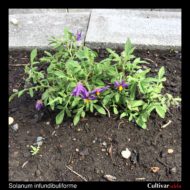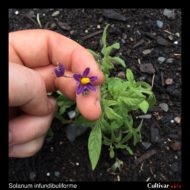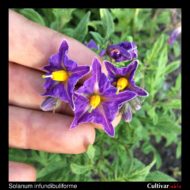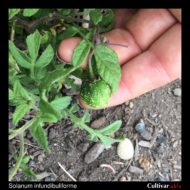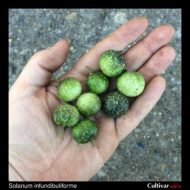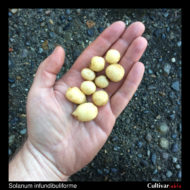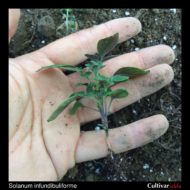Solanum infundibuliforme
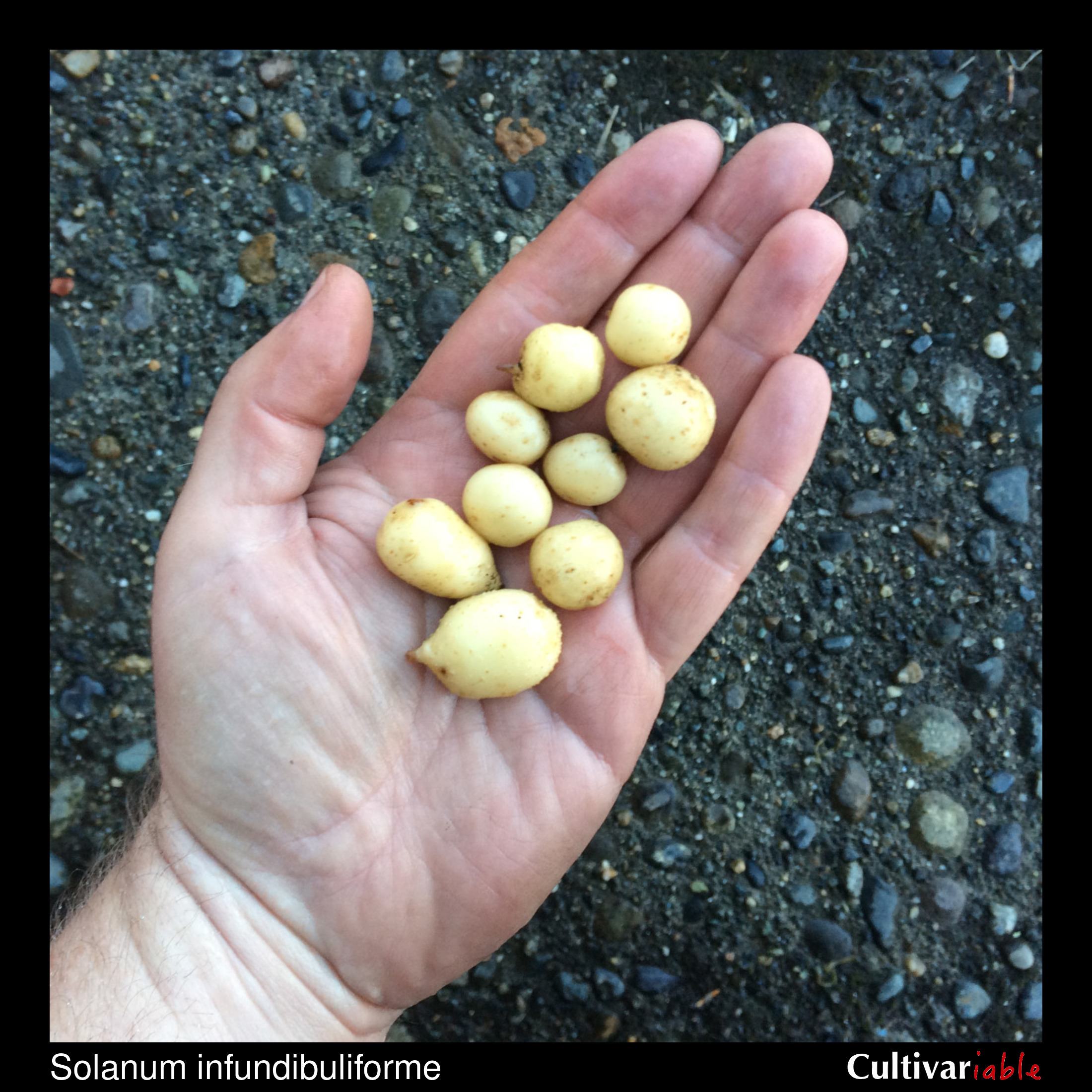
| Common Names | |
| Code | ifd |
| Synonyms | S. glanduliferum, S. xerophyllum |
| Clade | 4 |
| Series | Cuneoalata |
| Ploidy | Diploid (2x) |
| EBN | 2 |
| Tuberization Photoperiod | Short Day |
| Self-compatibility | No |
| Nuclear Genome | A |
| Cytoplasmic Genome | Unknown |
| Citation | Philippi: Anales Mus. Nac., Santiago de Chile 1891: 65. 1891. |
Description
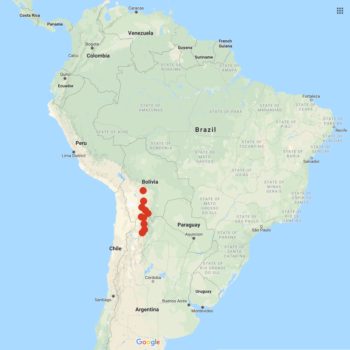
Solanum infundibuliforme is a high altitude species, growing natively in dry regions with almost year-round frost exposure, similar to S. acaule. Small plants, about 4 to 10 inches tall. Fuzzy leaves and stems. Stolons reach about two feet. Tubers small, mostly round, mostly less than an inch in diameter, occasionally reaching about two inches in cultivation. It is native to the three border region of southern Bolivia, northeast Chile, and northwest Argentina.
The specific epithet, infundibuliforme, means “funnel shaped,” referring to the flowers. It is formed from the Latin words “infundibulum,” for “funnel,” and “forma,” for “shape.” While there is no completely standardized pronunciation for scientific names, the most common way to pronounce this species is probably so-LAY-num in-fun-dib-yoo-lih-FOR-mee.
Resistances
This species can survive frosts down to 26 degrees F (-3.5 C) (Li 1977). Vega (1995) found that this species is more frost tolerant than domesticated potato.
| Condition | Type | Level of Resistance | Source |
|---|---|---|---|
| Alternaria solani (Early Blight) | Fungus | Somewhat resistant | Jansky 2008 |
| Frost | Abiotic | Somewhat resistant | Machida-Hirano 2015 |
| Fusarium sambucinum (Fusarium Wilt) | Fungus | Not resistant | Lynch 2003 |
| Globodera pallida (Pale Cyst Nematode) | Invertebrate | Resistant resistant | Castelli 2003 |
| Globodera pallida (Pale Cyst Nematode) | Invertebrate | Resistant | Bachmann-Pfabe 2019 |
| Globodera rostochiensis (Potato Cyst/Golden Nematode) | Invertebrate | Somewhat resistant | Castelli 2003 |
| Leptinotarsa decemlineata (Colorado Potato Beetle) | Invertebrate | Somewhat resistant | Machida-Hirano 2015 |
| Myzus persicae (Green Peach Aphid) | Invertebrate | Somewhat resistant | Machida-Hirano 2015 |
| Pectobacterium carotovorum (Blackleg/Soft Rot) | Bacteria | Not resistant | Chung 2011 |
| Phytophthora infestans (Late Blight) | Fungus | Not resistant | Bachmann-Pfabe 2019 |
| Potato Leaf Roll Virus (PLRV) | Virus | Somewhat resistant | Machida-Hirano 2015 |
| Potato Virus Y (PVY) | Virus | Not resistant | Cai 2011 |
| Sclerotinia sclerotiorum (White Mold) | Fungus | Not resistant | Jansky 2006 |
| Synchytrium endobioticum (Wart) | Fungus | Somewhat resistant | Machida-Hirano 2015 |
Glykoalkaloid content
Little information is available about the glycoalkaloid composition of this species. Petersen (1993) reported that the primary alkaloid is solanidine, which usually indicates that the glycoalkaloids are solanine and chaconine.
Tubers that I have sampled had good flavor but a slightly bitter aftertaste, so this species is probably not safe to eat.
Images
Cultivation
The USDA potato genebank has observed that some accessions of this species are dependent upon GA3 for germination (Bamberg 1999).
Towill (1983) found that seeds of this species stored at 1 to 3 degrees C germinated at 86% after 12 years and 46% after 18 years.
Trapero-Mozos (2018) determined that this species will tolerate a temperature of 40 C after acclimation for a period of time at 25 C.
Breeding
A mutation was discovered in S. infundibuliforme, called topiary. It is a single recessive gene, tp (Leue 1982), located on chromosome 3 (Wagenvoort 1988), that affects growth habit and tuberization. According to Den Nijs (1980), the mutation removes apical dominance so that the plant becomes short and bushy. At the same time, it causes early and extended tuber growth and much shorter stolons. This can have the effect of overcoming short day photoperiod.
Crosses with S. tuberosum
| Female | Male | Berry Set |
Seed Set | Germ | Ploidy | Source |
|---|---|---|---|---|---|---|
| S. infundibuliforme | S. tuberosum | None | None | Jackson (1999) | ||
| S. tuberosum | S. infundibuliforme | None | None | Jackson (1999) |
Crosses with other species
Jackson (1999) found 5-13% 2n pollen for varieties of this species.
| Female | Male | Berry Set |
Seed Set | Germ | Ploidy | Source |
|---|---|---|---|---|---|---|
| S. boliviense | S. infundibuliforme | High | High | High | Ochoa (1990) | |
| S. brevicaule | S. infundibuliforme | High | High | High | Ochoa (1990) | |
| S. infundibuliforme | S. anamatophilum | Low | Low | Yes | Ochoa (1990) | |
| S. infundibuliforme | S. berthaultii (as S. tarijense) | Yes | Yes | Yes | Ochoa (1990) | |
| S. infundibuliforme | S. boliviense | High | High | High | Ochoa (1990) | |
| S. infundibuliforme | S. brevicaule | High | High | High | Ochoa (1990) |
References
Solanum infundibuliforme at Solanaceae Source

